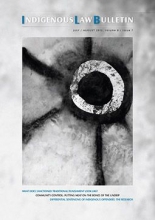Indigenous Law Bulletin 2013 Volume 8 Number 7

EDITORIAL
We begin this edition looking at the 2013 Federal Election. In the context of this election, Michelle Deshong examines the way gender and race debates may impact on the formal participation of Aboriginal and Torres Strait Islander people, and women specifically, within the current political landscape.
Next, Ken Lechleitner shares his knowledge of the nature and orgins of Australia’s Aboriginal peoples’ law. In particular, Ken explains the place of ‘traditionally sanctioned punishment’ within this system of law and describes what it looks like.
Megan Davis turns our attention to the United Nations Declaration on the Rights of Indigenous Peoples and addresses the implementation of the Declaration in relation to the right to health and self-determination.
Christine Bond and Samantha Jeffries present a brief overview of the current status of Australian research on Indigeneity and sentencing outcomes in the adult conventional (higher and lower), problem solving and Indigenous sentencing courts.
Margaret Raven and Ilan Katz report on the main findings of an evaluation of the Cape York Welfare Reform Trial implemented in the communities of Aurukun, Coen, Hope Vale and Mossman Gorge.
With reference to the fact that Indigenous children and young people are over-represented in the Australian child welfare system, Susan Baidawi, Philip Mendes and Bernadette Saunders review the available information concerning the Indigenous out of home care population with particular reference to Victoria.
Next, Simon Rice looks at the recent High Court judgment in Joan Monica Maloney v The Queen [2013]. In his relatively brief report on the case, Simon notes the principal points made by the Court and concentrates on one: the steps that must be taken for a law to be validly a special measure.
Finally, to mark the 50th anniversary of the Yirrkala Bark Petitions, we have reproduced the text of the Petitions. Sent by the Yolgnu people of Yirrkala to the Federal House of Representatives in 1963, the petitions are credited with giving awareness to Indigenous land rights claims.
This is my last edition as Editor of the ILB. I have thoroughly enjoyed being able to provide you with commentary on the relationship between Indigenous peoples and the law during my time as Editor. To my Indigenous Law Centre colleagues, Editorial Board, designer, contributors, artists and subscribers—thank you all for a rewarding experience and the tremendous work that you do.
Robert McCreery
Editor
CONTENTS
INDIGENOUS POLITICAL ASPIRATIONS AND THE TIDES OF CHANGE
by Michelle Deshong
WHAT DOES SANCTIONED TRADITIONAL PUNISHMENT LOOK LIKE?
by Kenneth Lechleitner
COMMUNITY CONTROL AND THE WORK OF THE NATIONAL ABORIGINAL COMMUNITY CONTROLLED HEALTH ORGANISATION: PUTTING MEAT ON THE BONES OF THE UNDRIP
by Megan Davis
DIFFERENTIAL SENTENCING OF INDIGENOUS OFFENDERS: WHAT DOES RESEARCH TELL US?
by Christine Bond and Samantha Jeffries
EVALUATION OF THE CAPE YORK WELFARE REFORM TRIAL
by Ilan Katz and Margaret Raven
INDIGENOUS YOUNG PEOPLE LEAVING OUT OF HOME CARE IN VICTORIA: A LITERATURE REVIEW
by Susan Baidawi, Philip Mendes and Bernadette Saunders
CASENOTE: JOAN MONICA MALONEY V THE QUEEN [2013] HCA 28
by Simon Rice
YIRRKALA BARK PETITIONS
by Errin Walker
Regulra
MONTHS IN REVIEW – July / August
compiled by Errin Walker
